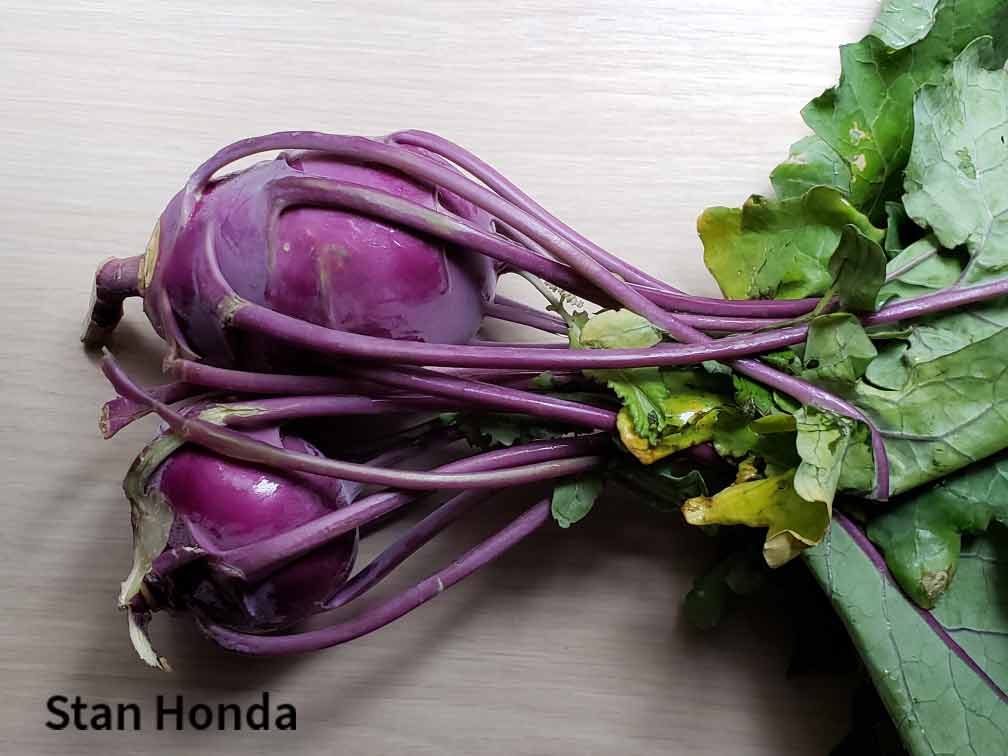KOHLRABI
Kohlrabi is a lesser-known vegetable that looks like it came from another planet. Many members encounter kohlrabi for the first time in their CSA share. It can be a bit daunting at first sight, with protruding antennas and a tough outer skin. But once peeled, it is a versatile vegetable with a mild taste, easily adaptable and full of potential.
It can be eaten both raw and cooked. The leaves are also edible and can be cooked like other greens.
Varieties in Your Share

GREEN KOHLRABI

PURPLE KOHLRABI
Storing: Kohlrabi lasts a long time; it’s crunchiest the first week after being picked, but perfectly fine for cooking after a month or longer if stored properly. To store, remove the leaves and stems (save these! we have some great ideas below), wrap the bulbs in a damp paper towel, put them in a cotton mesh bag or a plastic bag with holes in it, and refrigerate in the crisper drawer.
Store the leaves and stems as you would other greens, in a plastic bag with holes in your crisper drawer. Add a paper towel to absorb excess moisture. Use the greens within a week.
Avoiding waste: Don’t discard the stems and leaves. The leaves can be added to other cooking greens. The leaves are semi-tough, so if you’re cooking them with lighter greens like mizuna or spinach, put in the kohlrabi 1-2 minutes before adding the other greens. If you’re cooking them with kale or collards, they’ll take about the same time.
The stems are a good addition to a soup stock. You can also freeze them for later use.
Preserving: Kohlrabi can be frozen, but it’s best to blanch it first. Blanching stops the ripening process, which can continue even in the freezer. Peel the bulbs and cut them into cubes, then drop them into boiling water for 3 minutes. Drain, cool, and pack into ziplock bags, removing as much air as possible. They won’t be crunchy anymore when thawed, but they work well in soups and stews. Kohlrabi can also be pickled.
Kohlrabi’s finest role may be as the star of the crudité platter – it’s crisp, holds its shape, and doesn’t have a strong taste of its own. Simply peel and slice it into rounds, ovals, or spears. If you have a mandoline, this is the time to bring it out. You’ll find a batch of dips in the recipe section below.
Thin slices of kohlrabi add a layer of crunch to sandwiches and wraps. The mandoline is great for this also. Kohlrabi has a high water content, so you can let the slices drain on paper towels so that they don’t make the bread or other ingredients wet.
Kohlrabi can also be added to salads and slaws, sliced, chopped, or grated. It can also be cooked, which mellows its flavor and makes it sweeter and more tender. Any mashed potato dish can be enhanced with kohlrabi, which is lower in calories and carbohydrates than potatoes.
Cut off the leaves and put them with the rest of your cooking greens. Then cut off the stems and reserve them for your next batch of stock. Now you have a simple bulb. Slice off the toughest parts with a knife and prepare based on your cooking method. If the skin is thick and rubbery, remove it with a vegetable peeler.
Remember: Vegetables lose nutrients as they are cooked. Choosing a method with less cooking time preserves vitamins and other nutrients.
Roasting/Broiling: Cut into chunks and toss with a little oil, sprinkle with salt and pepper, and roast in a 375 F oven until soft and golden, about 25 minutes. You can also broil it on high for 3-4 minutes, watching it carefully. Kohlrabi’s flavor is mild, so consider cooking it with more flavorful vegetables or adding herbs or spices.
Steaming/Microwaving: Slice and steam for a couple of minutes, over water or in a microwave. Then use in soups or frittatas, or spice it up and use as a side dish.
Sauteing/Stir-Frying: Cut into thin slices or small chunks. Heat butter or oil in a heavy skillet, then add kohlrabi and toss for 3-5 minutes until soft and beginning to brown. For more flavor, sauté chopped onion or garlic in the pan before adding the kohlrabi.
Braising: After sautéing/stir-frying for a few minutes, add water, broth, wine, juice, or stock and continue cooking for 10-15 minutes, until very soft. If you prefer it less soupy, simmer until the liquid is reduced or evaporated, then toss over low heat for a few minutes until it browns.
Boiling: Kohlrabi can be boiled in water until very soft. Boiled kohlrabi on its own is not very appealing, but if you boil it with other vegetables—potatoes, sweet potatoes, carrots, parsnips—it adds its own mild flavor. Kohlrabi has fewer calories and carbs than most root vegetables, so combining them lowers overall calorie and carb counts.
RECIPES
MISC
Kohlrabi is a major supplier of Vitamin C; a cup of raw kohlrabi (135 g) provides 93% of the daily value of Vitamin C. It is also a good source of copper, fiber, Vitamin B6, and potassium, while being low in calories and carbs.
Source: https://fdc.nal.usda.gov/fdc-app.html#/food-details/168424/nutrients
Kohlrabi is a quick-growing cool-season plant. It’s one of the first “hard” vegetables that appear in our shares because it takes only about 45-60 days to mature. Kohlrabi likes cool weather; by the time temperatures reach 75 F, it begins to deteriorate.
Kohlrabi is not a root vegetable; the part we eat is a bulblike stem that grows above ground.
Kohlrabi is one of the only vegetables that originated in Europe. It has been popular in Europe, especially in Germany but also in Italy, Spain, and other European countries, since the 16th century CE. Kohlrabi was first described by botanists in 1554 and was commercially produced in Ireland in 1734. It also spread to Asia—it’s used in several Vietnamese and Indian dishes. It came to America in the early 1800s, when Eastern European immigrants brought it with them.
Kohlrabi is also called “German turnip” and its name comes from the German words for cabbage (kohl) and turnip (rabi).
CONTRIBUTOR


